Numerous digital and virtual artistic initiatives have emerged over the past year, partly despite/thanks to the corona crisis. Digital art in a virtual environment mainly focuses on visual arts, whether or not in a digital twin environment. Only a few initiatives, such as Area for Virtual Art or CIVA Festival (both initiated by sound:frame), break with the known (digital) artistic reference frames, but they still underexpose the performing arts.
The research groups Maxlab and CREATIE have spent the past year studying these virtual initiatives and also set up their own digital co-creation experiments within a virtual environment. An example of this are the different rooms in Mozilla Hubs, where a variety of parameters were investigated: live performance, co-creation, interdisciplinarity within a digital context, digital experience and dynamic interaction.
What follows is a visual report of these rooms - a series of photographs as the witness of an immersive exploration in Mozilla Hubs.
Lockdown Lobby
The Lockdown Lobby originated as an initiative to break the routine in daily livestreams. Although the artistic world continued to spew livestream performances in March and April 2020, from May onwards it became pretty annoying to stare at a YouTube or Vimeo interface yet again.
Originally this art lounge in Mozilla Hubs was a reaction to all those livestreams. We wanted to bring an audience back together and let them collectively give their uncensored opinions on new creations and compositions via their avatars.
Each lockdown composition (collaborations between contemporary flutist Ine Vanoeveren and several international composers) was presented in a customized setting in Mozilla Hubs – in order to digitally reinforce the musical narrative because of visual immersion in a virtual space.
But soon enough the space developed into a virtual lounge for digital art: 3D- models, digital scans, photos and GIFs from researchers at Maxlab and CREATIE filled the Lobby.
In January 2021, we organized a virtual premiere party, presenting Trumpet Vine, a new composition by Jason Eckard for alto flute solo, with animations by Geoffa Fells.
Musical and artistic friends from all over the world were present, and for a moment we felt like we were really at a premiere again. Eckardt received live compliments on his new composition, an experience he had to miss for almost a year because of those damn YouTube livestreams.
Even though a bad internet connection occasionally occurred, we actually concluded the evening with a virtual dance party to the tunes of YMCA. The combination with a festive gin-tonic made the experience complete and for a moment the craving for physical performances disappeared. Or at least for a very short while.
Visit the Lockdown Lobby here in Mozilla Hubs.
Concept, design and performance: Ine Vanoeveren
Compositions: Anahita Abbasi, Jason Eckardt, Geoffa Fells, Marcelo F. Lazcano, Frederik Neyrinck
Featured Artists: Janna Beck, Umut Eldem, Max Schweder, Kristof Timmerman
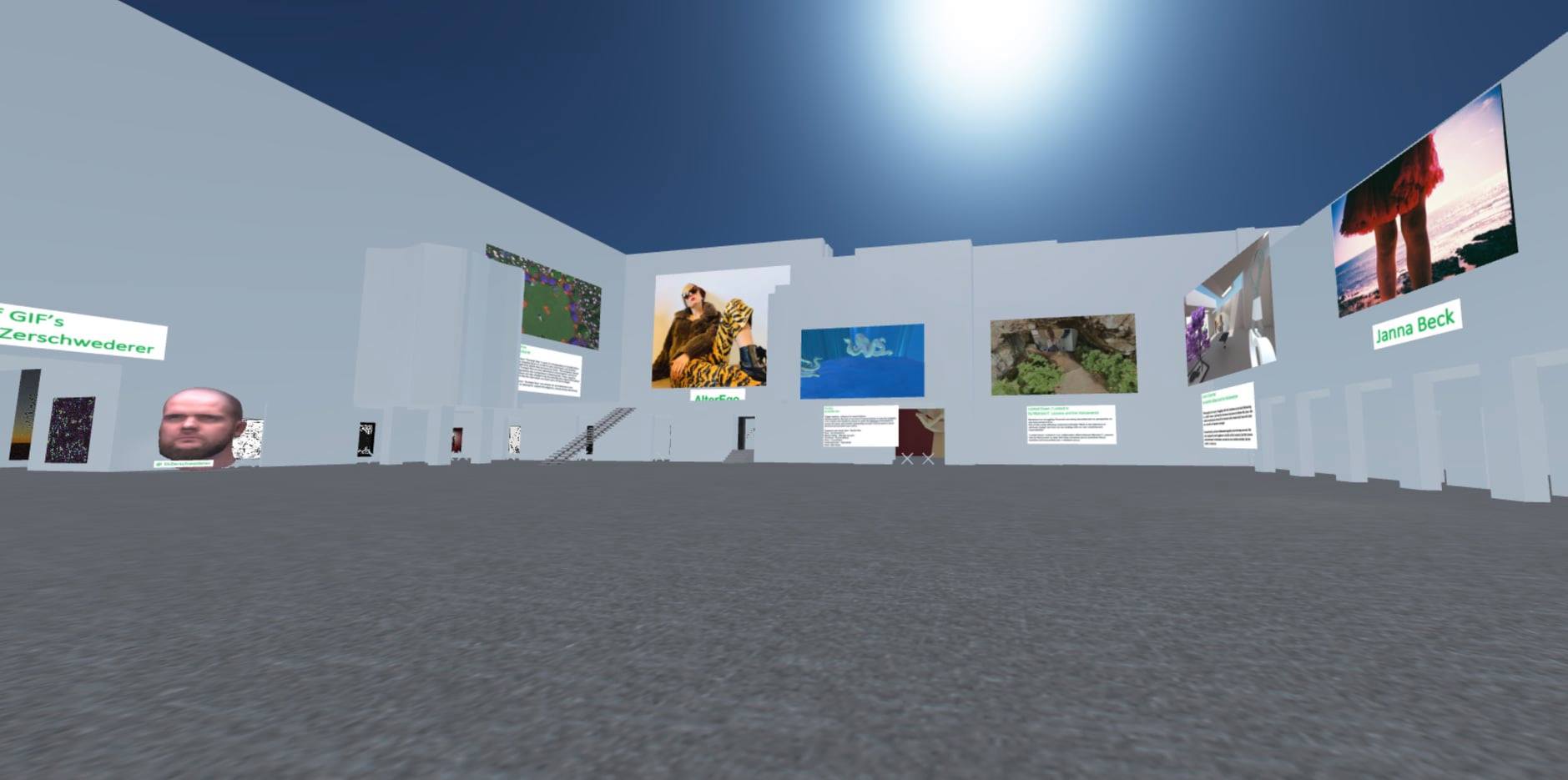
Lockdown Lobby
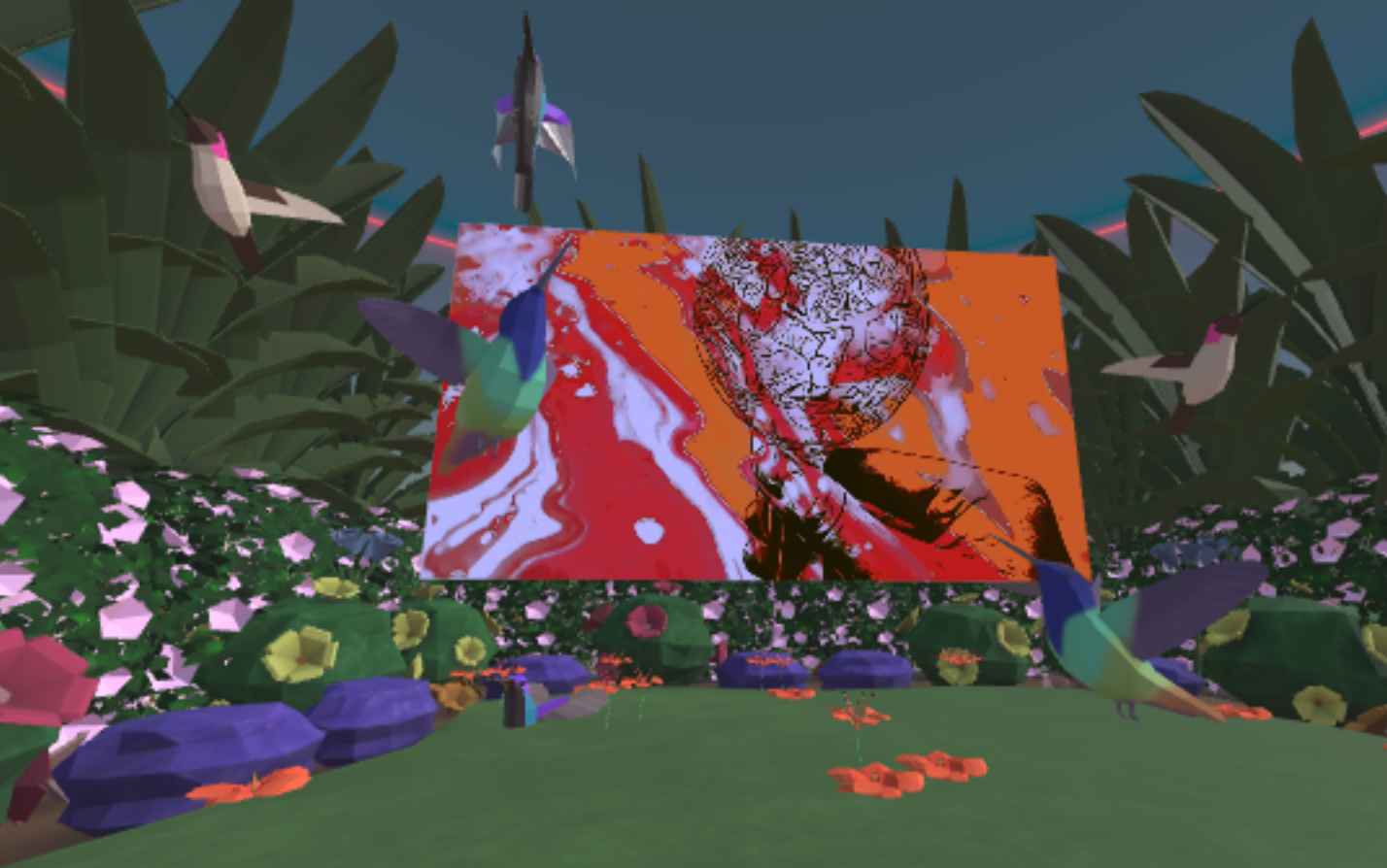
Trumpet Vine Room

Octopus Room
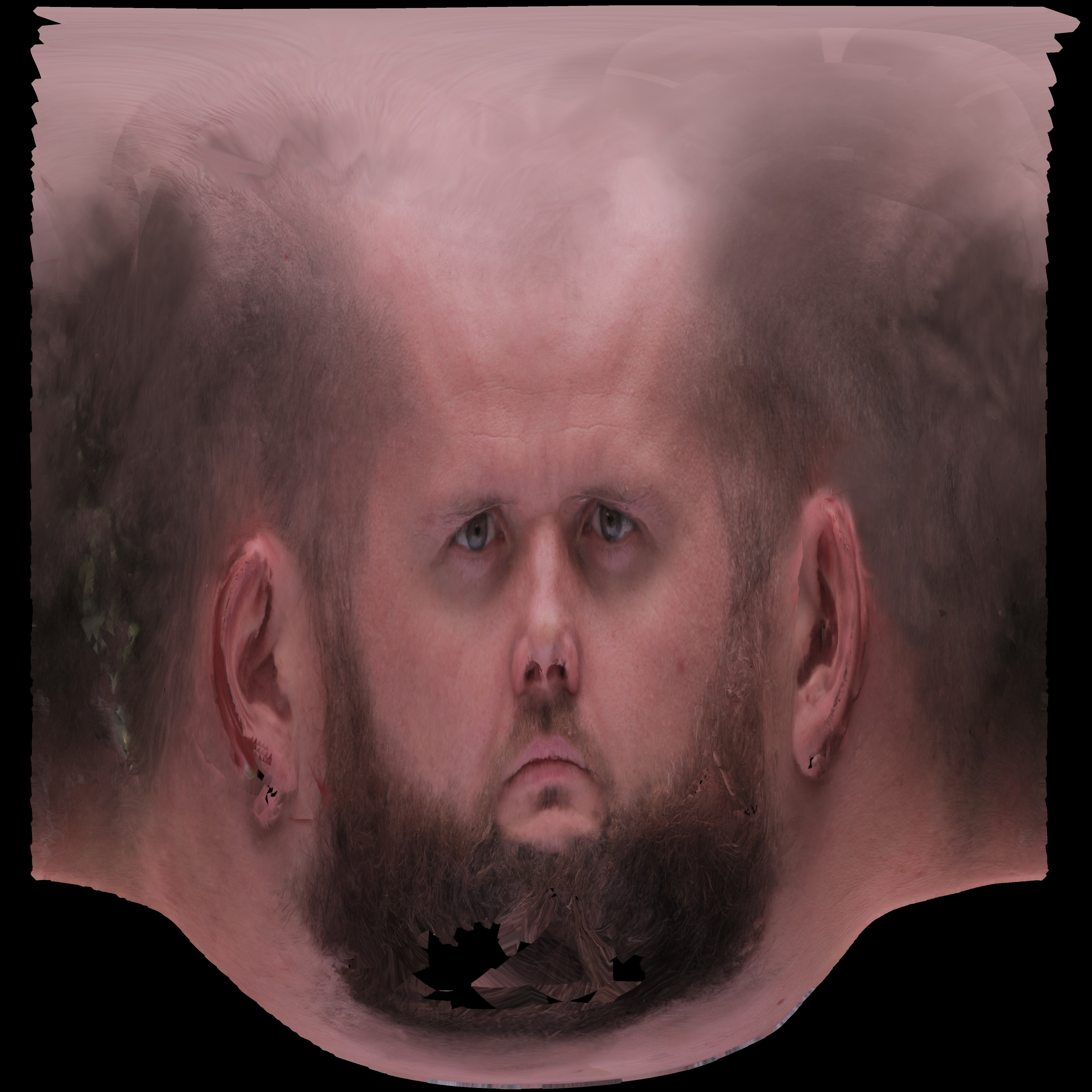
Max Schweder
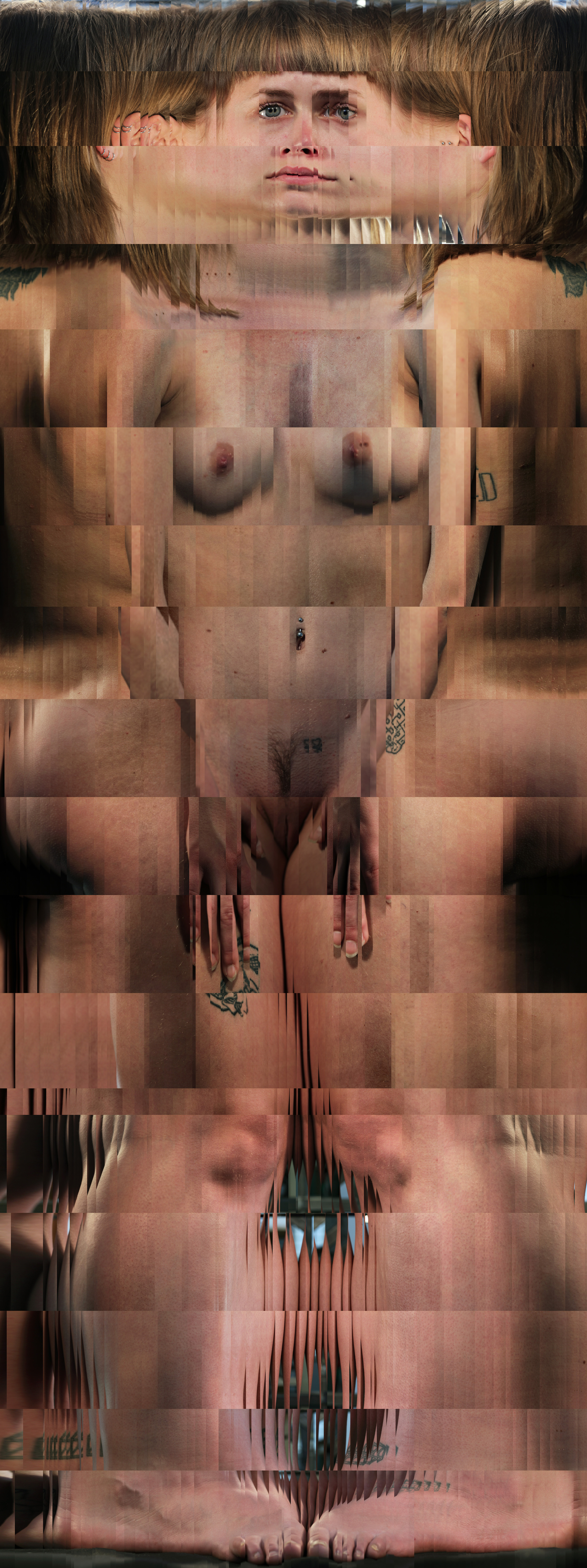
Kristof Timmerman
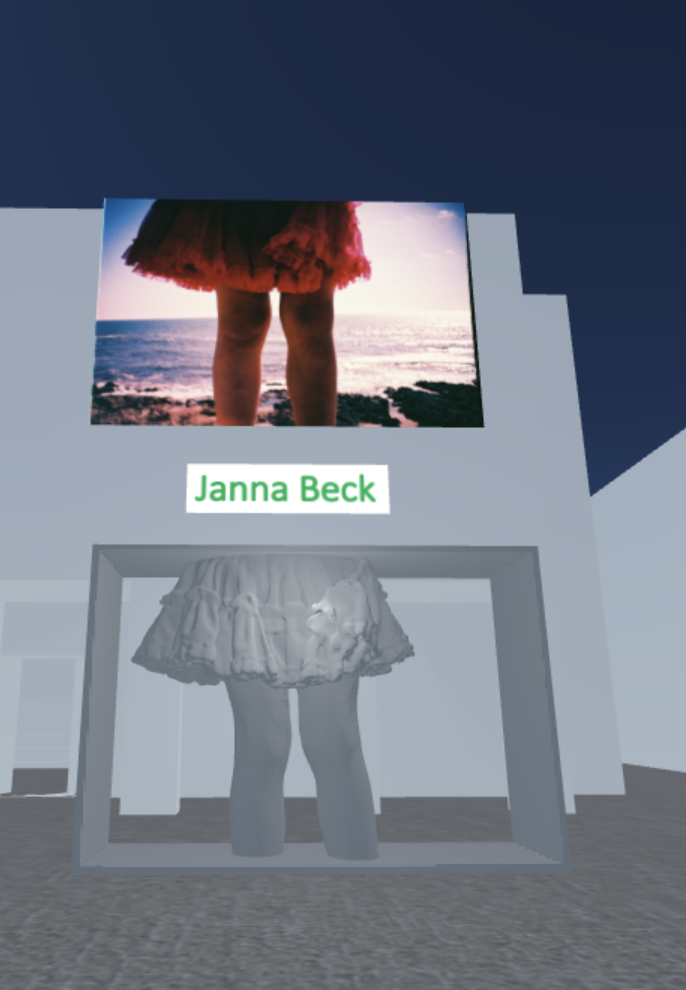
Janna Beck
Studio POC Lounge
One aspect that was not highlighted in the Lockdown Lobby is that of a digital live performance. Each work, each video, each performance can be viewed and experienced permanently, but they didn’t have a public live premiere.
During NextDoors 2021, the annual interdisciplinary project week at the Royal Conservatoire Antwerp, Studio POC wanted to offer a digital alternative to students for their cancelled NextDoors festival. With the Inclusiv/Exclusiv project, the art activities normally on display inside campus deSingel, were now brought out into the open.
During this event, motion graphics and experimental videos were projected onto the Immersive Cube, including videos by students of deKunsthumaniora!.
On the outside walls of deSingel people could experience live drawings and animations by students of the Royal Academy of Fine Arts, in dialogue with a live performance by jazz students from the conservatoire.
The entire event was dynamically streamed into the virtual Studio POC Lounge.
In the physical world the conservatoire’s jazz combo played at the entrance hall of deSingel, at the bottom of the stairs. In the virtual world, visitors could watch the energetic livestream all together on those same stairs. Avatars moved around the entire space, sometimes looking for a quieter spot to have a chat with a few friends. Thanks to the dynamic audio perception of Mozilla Hubs, avatars could ‘walk away’ for 10 virtual meters and have a chat without disturbing other visitors.
During the event they could also quickly take a look at Annelise Cerchedean's 3D exhibition.
In this way, the staircase of deSingel functioned as an artistic portal, with the live performance and the virtual livestream meeting each other on the same spot.
The concept of the event was entirely focused on the livestream in the virtual environment, precisely because no audience was allowed to be physically present during the recordings. Therefore, the setup, flow and narrative were developed entirely from a digital perspective, making the virtual experience even more exciting and valuable than the physical event. Thanks to an autonomous digital aesthetic, livestreams in a virtual setting can give an added value to a virtual audience.
Visit the Studio POC Lounge with the after movie of Inclusiv/Exclusiv here in Mozilla Hubs.
Room design: Max Schweder, Ine Vanoeveren
Virtual exhibition: Annelise Cerchedean
Livestream: Tom Dietvorst, Kristof Timmerman
Audio production: Jurgen Techel
Set-up and technique: Tom Dietvorst, Rik Suijs, Martine Thoné, Geert Van Impe
3D scanning: Annelise Cerchedean, Thomas Gladiné
After movie: Wes Nijssen
Coordination: Janna Beck, Kristof Timmerman, Ine Vanoeveren
With the support of Lab101, BeamInc and the city of Antwerp
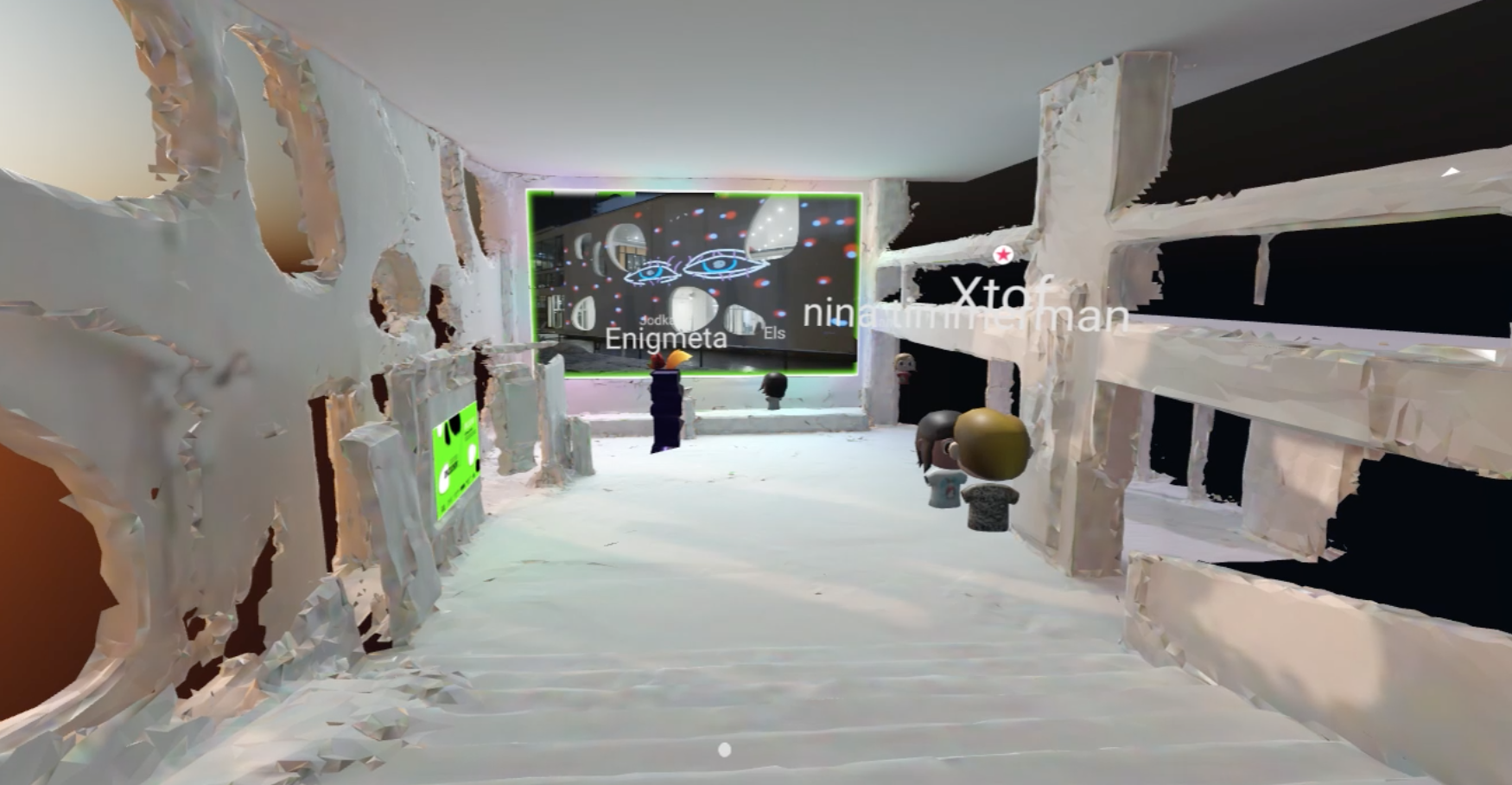

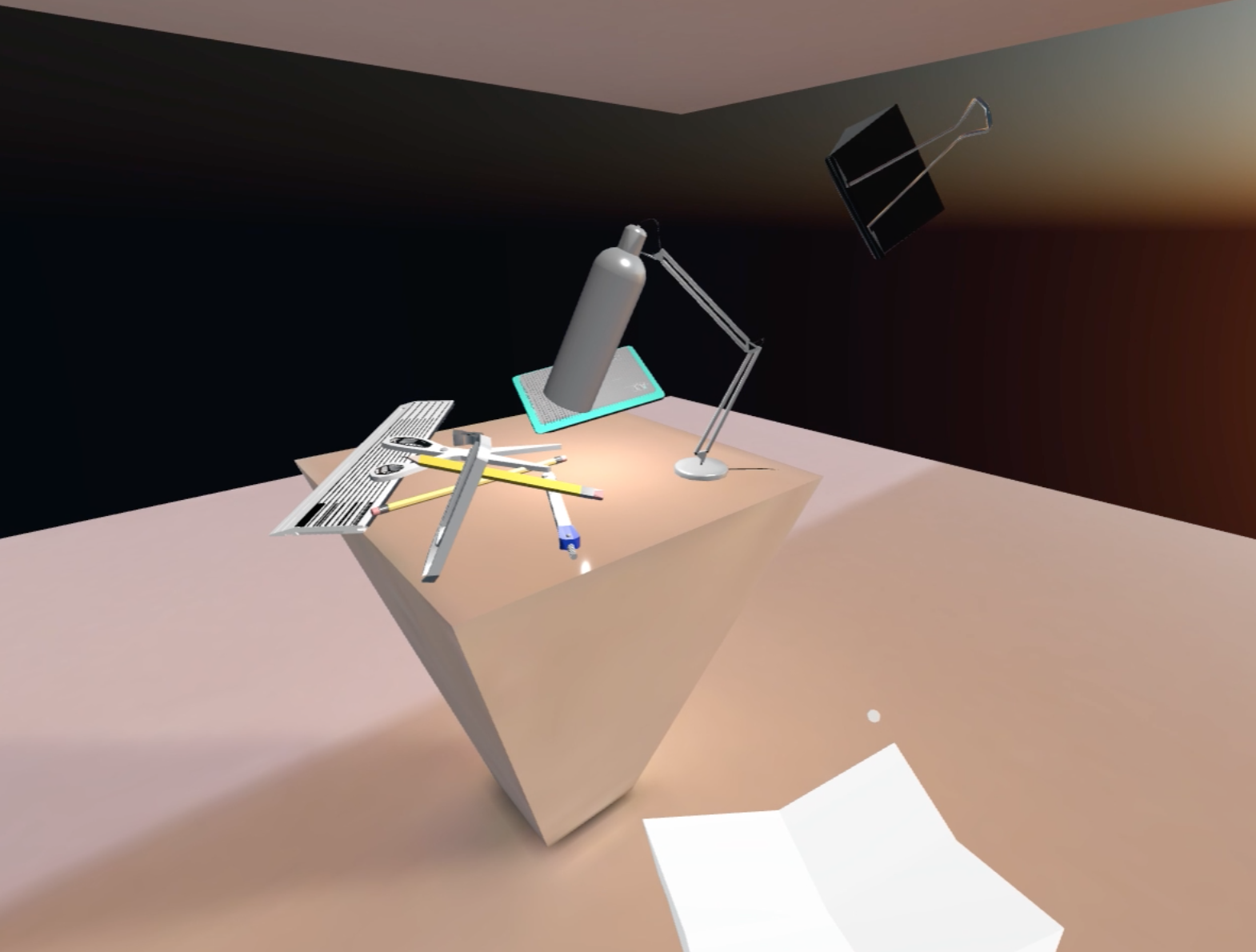
Anneliese Cerchedean

Virtual Academy & Conservatoire
The open house day of the Royal Academy of Fine Arts and the Royal Conservatoire Antwerp knew yet another digital version. During the first lockdown in April 2020, the open house day was quickly organized through Zoom and a chat box. Now, one year later, that bar had to be raised. The research groups Maxlab and CREATIE developed virtual spaces in Mozilla Hubs, which allowed future students to still experience a small part of that specific vibe of both art schools.
Students, dressed as host-avatar, were present to answer all the pressing questions of our next generation of students. Visitors were welcomed in the Fisherman's Lobby - a lobby that was designed by transforming a classical statue from the Academy into a low-poly giant. This lobby is a mashup of the Academy and the Conservatoire buildings, augmented with digital experiences.
Fisherman’s Lobby
Here is the story of the Royal Fisherman, who went fishing to clear his mind and fill it with new ideas. He tries to capture these ideas in the Royal Conservatory of Antwerp and the Royal Academy of Antwerp ...
In addition to being a general meeting place, the Fisherman's Lobby is also a display of the different features and options within Mozilla Hubs. For example, there is a film with output from researchers from Maxlab and CREATIE that is being played in a constant loop. The audio can only be heard from within a limited radius around the screen, leaving enough space to communicate with each other.

A little further down the corridors of the Academy, a statue is reciting Vers 6 by Paul Van Ostaijen, with the voice of poet Philip Meersman. The statue is made of 2 transparent png's placed perpendicular to each other. Via Soundcloud the statue 'recites' in a constant loop.



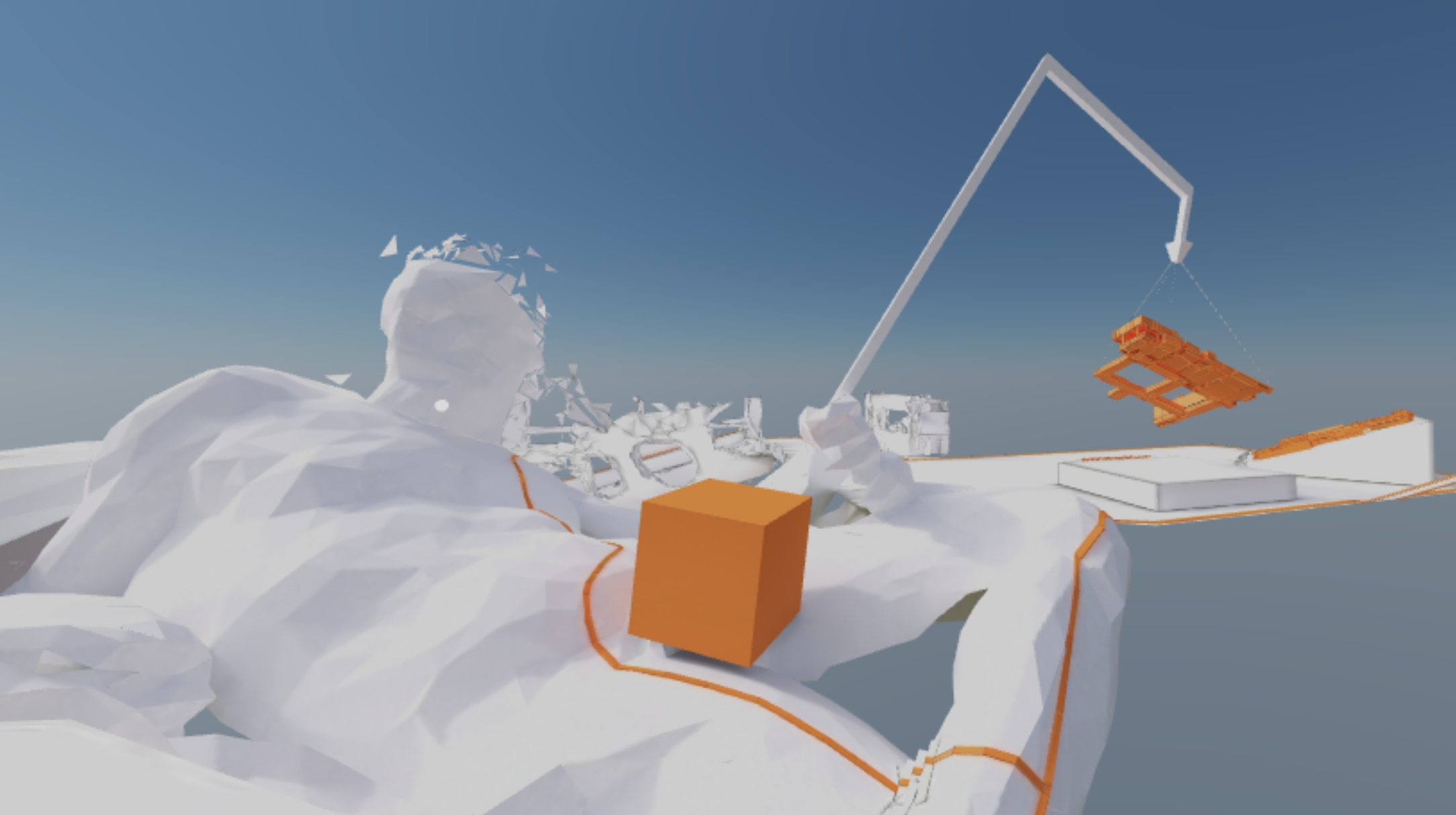
Cube Room
The orange lines delineate the route that visitors can follow, in order to explore all the rooms and installations. On the main statue is a large orange cube - the digital portal to the Cube Room. This room is the virtual twin of the Immersive Cube, a 3mx3mx3m cube, where images and animations can be projected along each side. Visitors can enter this cube, which means they are surrounded by digital projections. The same goes for the virtual cube in the Cube Room, where an immersive experience is being virtually recreated.



Exhibition spaces of the Academy and the Conservatoire
In addition to the Cube Room, visitors can also discover 2 other exhibition spaces. Both the Academy and the Conservatoire were given a virtual equivalent for the occasion, where prospective students and visitors could get an insight into the artistic process of both schools. Through the 3D models in the Fisherman's Lobby, visitors end up in the respective exhibition rooms.
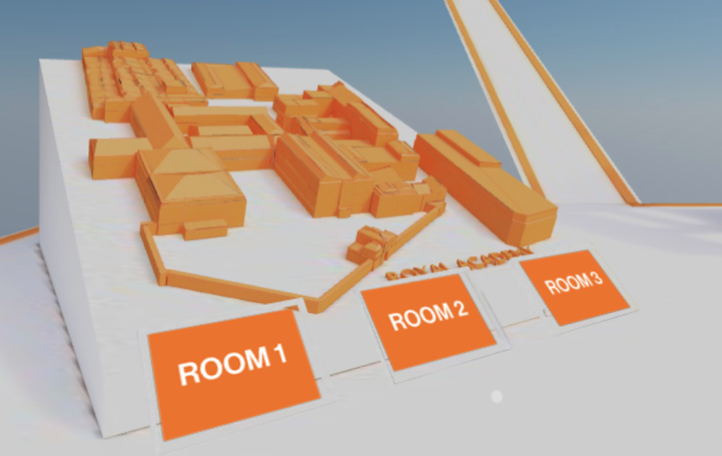

At the Academy, the garden and the Lange Zaal were virtually cloned. The garden features an exhibition of the various Instagram accounts of the Academy's programs, while the Lange Zaal is a motley collection of student works. Clickable GIFs bring visitors to an external webpage via a new tab, with the explanation and full video of the artworks. This makes it possible for visitors to look at a particular artwork together and still be able to talk to each other through the Mozilla Hubs space.
The Conservatoire is virtually represented through the iconic entrance of deSingel, where each of the various programs has been allocated their own corner. Visitors can walk from Jazz to Dance, via Classical Music and Drama. The same system of clickable GIFs is being used, so that visitors can enjoy a performance together and still keep in touch with each other in the Mozilla room.
The garden of deSingel has been transformed into a Listening Garden with podcasts by students of Word Art.
Both schools have their own 3D modeled and animated sculptures: a fuchsia two-headed horse for the Academy and several neon green chickens in the garden of the Conservatoire. At the Fisherman's Lobby, there is a flying a dragon. All of these objects are created by Jonathan Labiche.

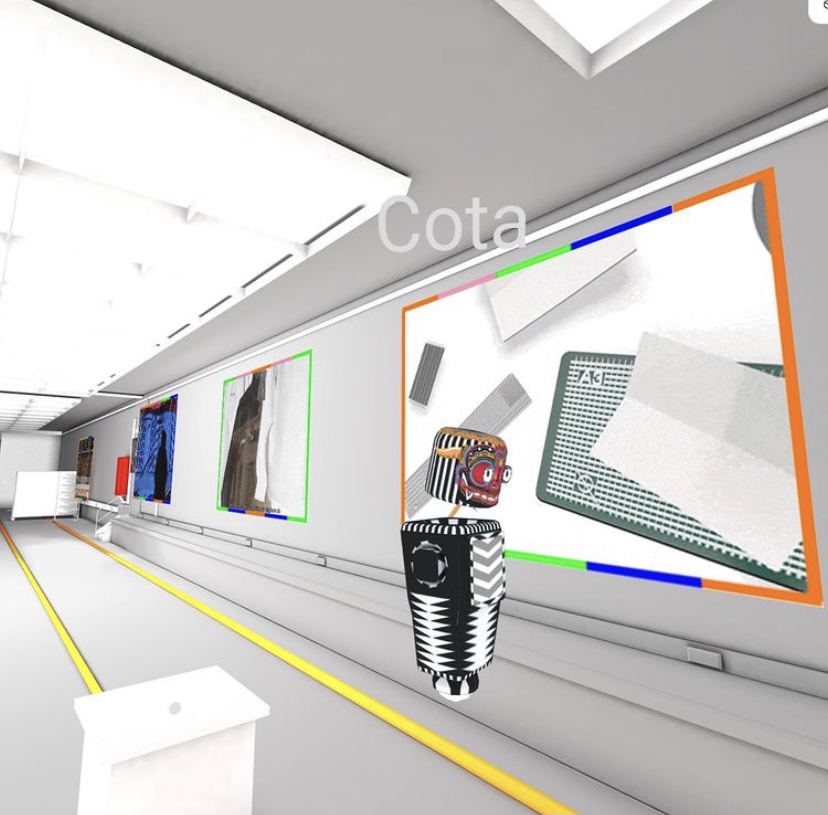

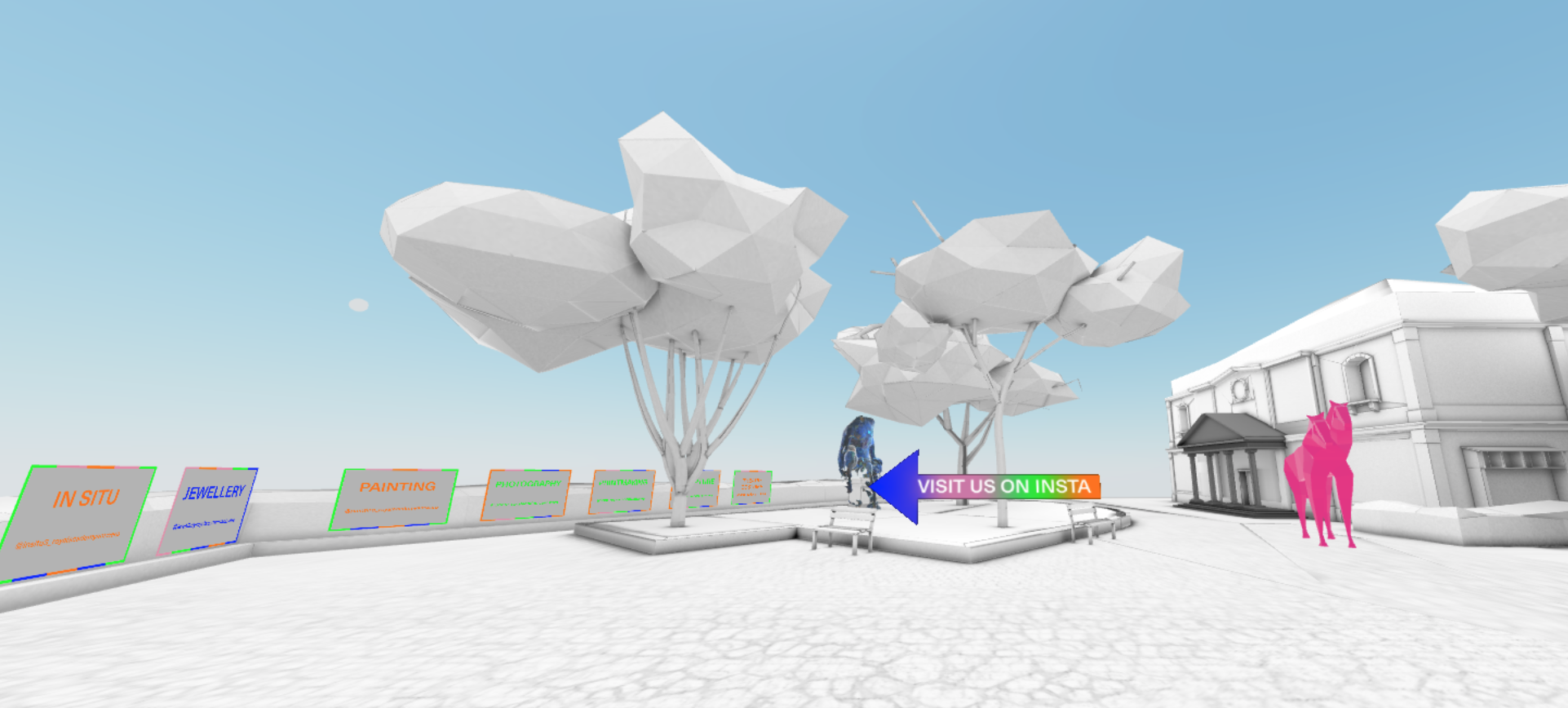

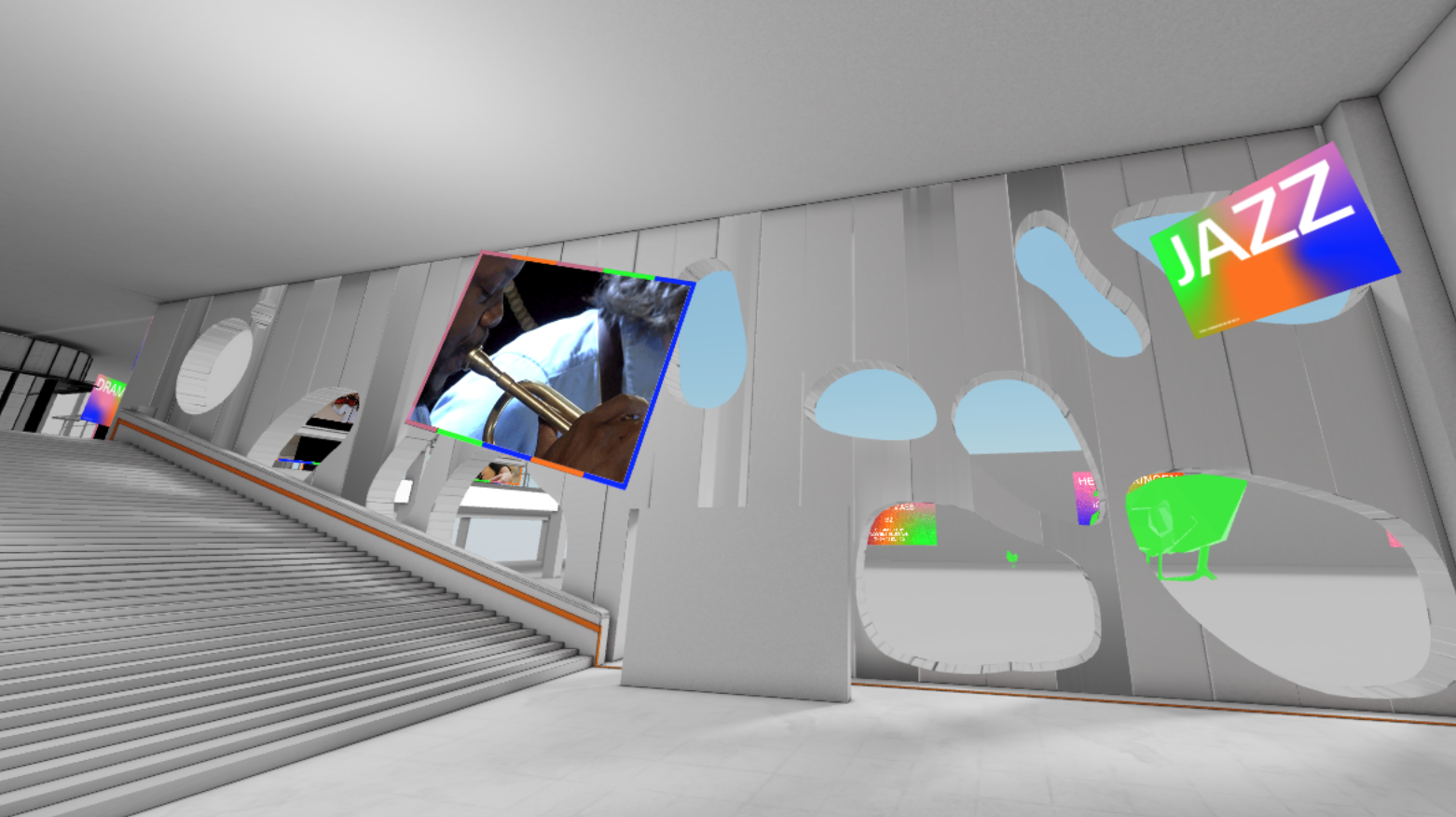
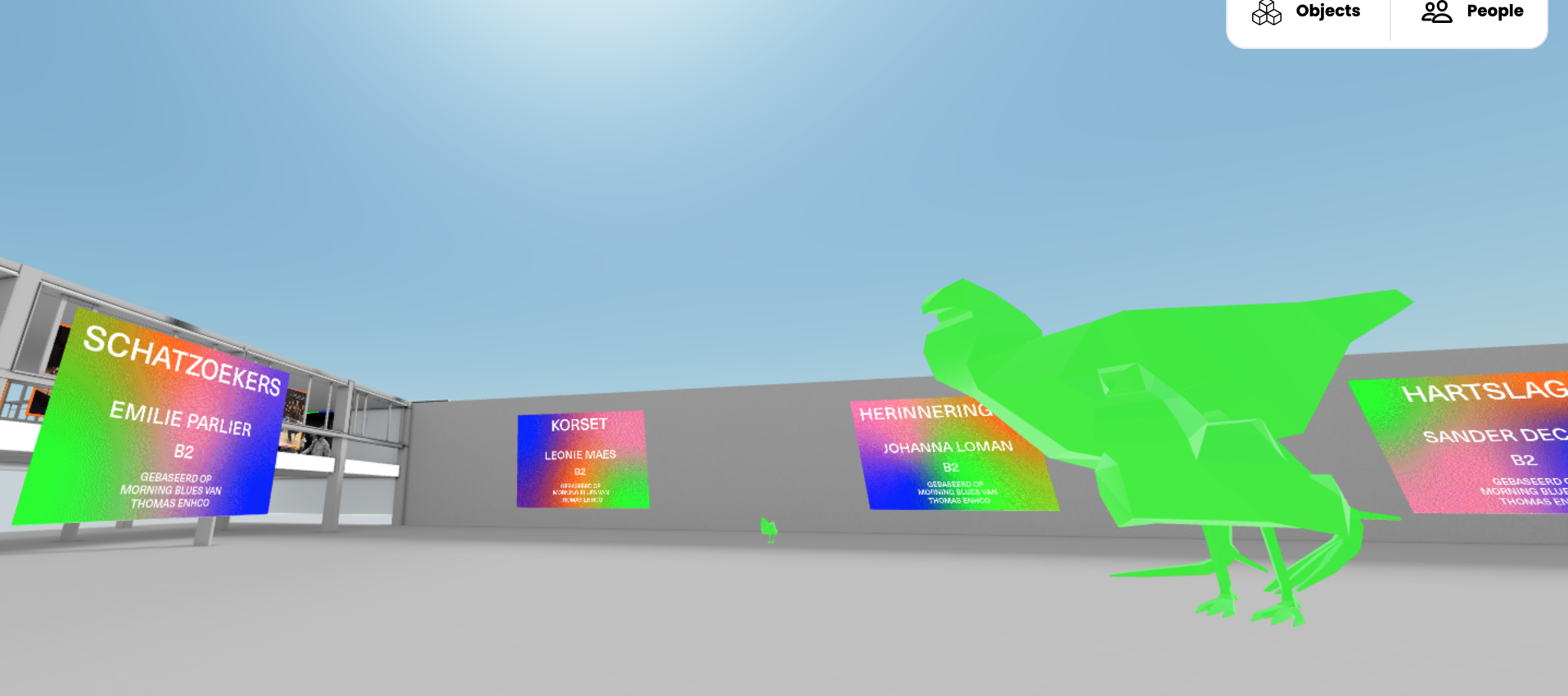

Empty Mind Project
Finally, we return to the Fisherman's Lobby. Inside the empty head of the Royal Fisherman is a digital installation, as part of the Empty Mind Project. Within that project, funded by DARIAH-EU, we are exploring ways to use existing virtual platforms in a modified way to create interdisciplinary digital live performances with a dynamically added value. A first step in this process is this virtual installation, where a 360° video is being placed inside the empty head of the main statue.
As with the big screen and the poetic statue, sound has been added within a very limited perimeter. Visitors must enter the head to hear the music - a live recording of the work for flute solo, "No I am not roaming aimlessly" by Iranian composer Anahita Abbasi. This composition is based on two different ideologies: Dialogical Self Theory and Sufism. Dialogical Self Theory interweaves two concepts, 'self' and 'dialogue', in such a way that a deeper understanding of the interconnection of 'self' and society is achieved. The basis of this work is the English translation of a poem by Rumi.
While surrounded by the music, visitors can step into the 360° video. Once inside this strange sphere, the visitor is being surrounded by a desolate, mystical landscape. In this way, both the image and the music create an immersive experience for the visitor, reinforcing the emotional narrative of the work in a multisensorial way.


Concept & Design | Schools of Arts
Janna Beck, Annelise Cerchedean, Thomas Gladiné, Jonathan Labiche, Max Schweder, Kristof Timmerman, Ine Vanoeveren
External Development & Design
Roman Senkl, Nils Corte, Nils Gallist, Armin Luschin
Visit the Fisherman's Lobby in Mozilla Hubs here for the full experience, or go directly to one of the exhibition spaces: Academy, Conservatoire, Cube Room.
Future research into digital live performance
In the upcoming years, Maxlab and CREATIE will continue researching and developing digital and virtual live performances. This will include an in-depth research into so-called artistic portals. These portals form the connection between physical and virtual performances. From what point onwards do performers and/or spectators feel part of the digital reality? Technology is important here, but at most it is a tool to support the graphic, spatial, narrative, ... construction.
Inevitably we come across the concept of 'immersion', but not in the popular, devalued sense as a reference to 'experience'. Immersion is the absorption of the perception of time and space into the new reality so that one is no longer aware of the environment in which they physically find themselves.
The next step of the DARIAH project is the development of an alternative platform for live performances with a Rokoko motion capture suit, accessible on most laptops and electronic devices. The team is being divided into 4 groups, each focusing on a specific part of the research and development process:
- performers & tools: examining data, gained from performance (movement and audio)
- data mining & transfer: technological support
- platform & interaction: development of the platform
- visuals & variable designs: avatars, surroundings and interactivity
The collaboration between the researchers from AP Hogeschool and the professional design team of Studio Plankton happens in a workshop format. Every month, we spend an afternoon together, developing, brainstorming, creating and exchanging expertise. By the end of the project, the research and development of the 4 teams will melt together for the final performance of Empty Mind.
Multidisciplinary team:
Janna Beck: graphic design
Umut Eldem: live electronics
Wim Henderickx: composer, live electronics
Kris Meeusen: 3D-animations
Wes Nijssen: Rokoko mocap suit specialist
Kristof Overdulve: ICT support and platform development
Max Schweder: digital artist, platform development
Studio Plankton: 3D-animations
Kristof Timmerman: artistic direction, production
Ine Vanoeveren: performer, artistic direction




